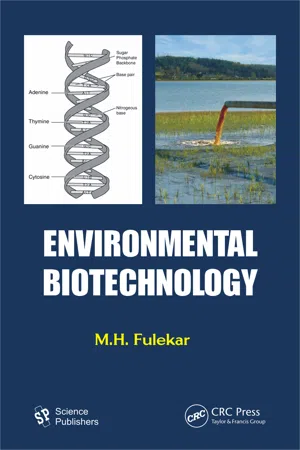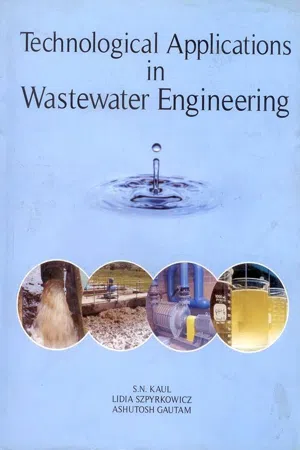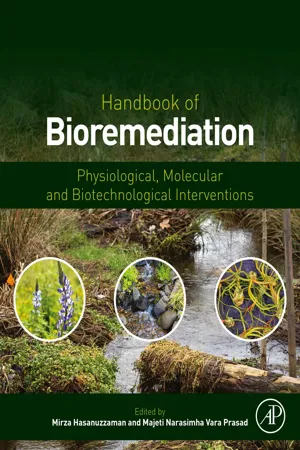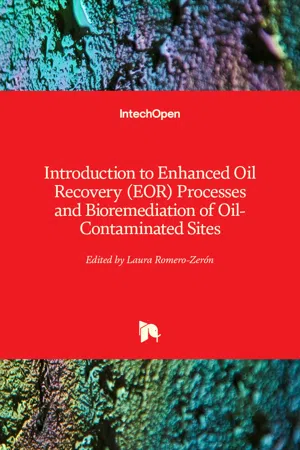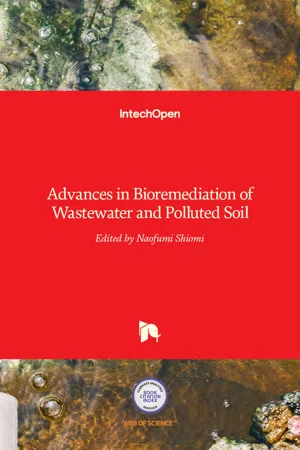Biological Sciences
Bioremediation
Bioremediation is a process that uses microorganisms, plants, or enzymes to remove or neutralize pollutants from a contaminated site. It is an environmentally friendly and cost-effective method for cleaning up hazardous waste and pollution. Bioremediation can be used to treat soil, water, and air contaminated with substances such as oil, heavy metals, and chemicals.
Written by Perlego with AI-assistance
Related key terms
1 of 5
10 Key excerpts on "Bioremediation"
- eBook - PDF
- M. H. Fulekar(Author)
- 2010(Publication Date)
- CRC Press(Publisher)
“Bioremediation—Remediate means to solve a problem and bio-remediate means to use biological organisms to solve an environmental problem such as contaminated soil or surface/ ground water. Bacteria, fungi, and other microorganisms are constantly breaking down organic matter in the contaminated environment. Some of the microorganisms would die, while others capable of eating the organic pollution would survive. Bioremediation works by providing these pollution-eating organisms with fertilizer, oxygen, and other conditions that encourage their rapid growth. These organisms would then be able to break down the organic pollutant at a correspondingly faster rate. In fact, Bioremediation is often help to clean up the environment”. 4.1 Bioremediation Bioremediation is a combination of two words — bio, short for biological, and remediation, which means to remedy. Bioremediation is not a new technology. There has been evidence that compost piles existed as far back as 6000 BC and in 1891 the first biological sewage treatment plant was created in Sussex, U.K. However, the word ‘Bioremediation’ is fairly new. Its first appearance in peer-reviewed literature was in 1987 (NABIR 2003). Bioremediation technology uses microorganisms to reduce, eliminate, or transform contaminants present in soils, sediments, water or air to benign products. Bioremediation depends on the CHAPTER CHAPTER Bioremediation TECHNOLOGY 4 presence of appropriate microorganisms in the correct amounts and combinations and on the appropriate environmental conditions. Microorganisms already living in contaminated environments are often well adapted to survival in the presence of existing contaminants and to the temperature, pH and oxidation/reduction potential of the site. These indigenous microbes tend to utilize the nutrients and electron acceptors that are available in situ, provided liquid water is present. The bulk of subsurface microbial populations are associated with the solid phase. - V. Sivasubramanian(Author)
- 2016(Publication Date)
- CRC Press(Publisher)
Moreover, due to the lack of public acceptance, complexity, and increased chance of exposure of workers and residents to contami-nants, these techniques have not been considered as advantageous (Vidali 2001). Also, these methods have resulted in large volumes of concentrated hazardous sludge, and so complete destruction of pollutants cannot be brought about. These drawbacks can be transcended by adapting a tech-nique that can efficiently destroy the pollutants or convert them into biodegradable substances. One such technique is Bioremediation . It is a competent method to clean the environment through natural biological activity, by which contaminants can be destroyed. As a cost-effective, eco-friendly, and environmentally friendly technology, Bioremediation has received public acceptance and can be carried out with ease at any loca-tion (Bhatnagar 2013). Bioremediation is broadly defined as a set of biological treatment systems to remediate contaminated sites by destroying or reducing the concentration of hazardous waste. Briefly, the process of remediation is brought about by biological entities such as microorganisms or plants, which convert hazardous waste into nonhazardous forms (Dwivedi 2012). Based on the process of removal and transport, Bioremediation is clas-sified into in situ and ex situ. In in situ remediation, contaminants are treated at the same site. Ex situ remediation involves complete transfer of contaminated material from the affected site to another place where the treatment is carried out by biological agents. These days, the ex situ mode of treatment is preferred over in situ for remediating contaminated water, soil, and environment (Vidali 2001). Role of Phytoremediation in Maintaining Environmental Sustainability ◾ 107 Depending on the material utilized to clean up the contaminated environment, Bioremediation is classified into three different meth-ods. Bioremediation by using fungus is known as mycoremediation.- Kaul, S N(Authors)
- 2021(Publication Date)
- Daya Publishing House(Publisher)
Chapter 9 Bioremediation: A Perfect Solution for Environmental Clean-up B.D. Bhawsar and B.A. Chopade* Department of Microbiology, University of Pune, Ganeshkhind Road, Pune – 411 007 *Corresponding Author: Tel.: +9102025690643, E-Mail: [email protected] ABSTRACT Bioremediation is a natural biological degradation process of removal of contaminants from polluted environments. It is different from chemical degradation in that instead of synthetic chemicals microorganisms are involved in decontamination. Bioremediation is cost effective process and the microbes present an essential role in pollution remediation. To know what is Bioremediation is to know how microbes clean the polluted environment. They remove, destroy toxic substances like thiocarbamates, herbicides, insecticides, organophosphorus compounds, chlorinated aliphatic and aromatic chemicals, aromatic amines, sulfonates, heavy metals and they convert lignin, cellulases, hemicellulases into fuels, solvents, SCPs and other useful products. Microbes also utilize xenobiotic substances as sources of carbon, nitrogen, sulfur, or phosphorus and transform these compounds into normal intermediates of central metabolism through their highly regulated enzyme systems. These microbes can be genetically modified to enhance and versatile their degradative potential. To the world facing increasing environmental pollution, currently available approaches to solve pollution problem such as incineration, excavation and storage are expensive, incomplete and again create additional problems of disposal. As compared to this, biodegradation is the most promising approach for environmental clean-up. Keywords : Pesticide degradation, Pollution Bioremediation, Heavy metal removal xenobiotic, Genetically modified microbes.- eBook - PDF
Bioscience Entrepreneurship In Asia: Creating Value With Biology
Creating Value with Biology
- Paul S Teng(Author)
- 2008(Publication Date)
- World Scientific(Publisher)
201 Chapter 7 Bioremediation Large tracts of land have been contaminated with toxic chemicals such as arsenic, mercury or high levels of salts because of industrial and farming activities, making these lands uninhabitable or unsuitable for crops. Fresh water bodies have similarly been contaminated. While mechanical and chemical cures are known for removing the toxic or unwanted chemicals, governments are increasingly searching for envi-ronmentally friendly techniques to “clean up” polluted lands and waters. One such set of techniques is called “Bioremediation”, or the use of microbes, plants or their enzymes to remedy contaminated land and water. Bioremediation is not a new phenomenon, but modern science has made it a potentially powerful ally by improving the efficiency of the organisms concerned, either using conventional selection or through genetic improvement. Much “upside” has yet to be exploited and can be done only through further investments in R&D. An appealing feature of Bioremediation is that the contaminated soil or water may be acted upon by organisms in situ (i.e., without removing the soil or water from their original site). Several types of Bioremediation techniques are in use; where plants are used to clean up the environment, the technique is called “phytoremediation”, comprising phytoextraction, phytodegrada-tion, phytotransformation, phytostabilization and rhizofiltration (use of plant roots to reduce contamination in wetlands and estuaries). Phytoextraction is a popular technique and much experience has been accumulated and shared within the scientific community to use specific plants for cleaning soil contaminated with heavy metals. 202 Bioscience Entrepreneurship in Asia The plant material is subsequently removed from the locale and incinerated. Besides using plants for Bioremediation, microorganisms can be used to accumulate pollutants in the environment. Bioremediation is not a new concept in the field of applied microbiology. - eBook - ePub
Handbook of Bioremediation
Physiological, Molecular and Biotechnological Interventions
- Mirza Hasanuzzaman, Majeti Narasimha Var Prasad, Majeti Narasimha Vara Prasad(Authors)
- 2020(Publication Date)
- Academic Press(Publisher)
Ashraf et al., 2019 ). Considering the need to increase knowledge about sustainable techniques for the remediation of contaminated environments through biological organisms and plants, because they can absorb and/or convert inorganic contaminants, in this chapter, we elucidate the concept of Bioremediation and describe the possible mechanisms of different Bioremediation strategies to be applied in contaminated sites by inorganic pollutants. Furthermore, an attempt has been made to review the challenges and opportunities of the Bioremediation for remediating toxic metals and inorganic pollutants from contaminated media.2: Concept of Bioremediation—A convenient solution to the contamination of inorganic pollutants
Bioremediation has been defined as “Use of living organisms to clean up or remove pollutants from soil, water, or wastewater; use of organisms such as nonharmful insects to remove agricultural pests or counteract diseases of trees, plants, and garden soil,” as reported by US EPA, United States Environmental Protection Agency (Cristaldi et al., 2017 ). This activity can be carried out by green plants that are able to remove pollutants from the soil or water by absorption through the roots and next accumulation into the leaves. It also can make use of microorganisms to detoxify or remove inorganic pollutants from the environments (Khalid et al., 2017 ). Bioremediation also offers a permanent in situ remediation rather than simply translocating the problem. This technique can be used for remediation of heavy metals, metalloids, or other inorganic pollutants from soil or water (Ali et al., 2013 ; Ashraf et al., 2019 ). It is proved cost-effective, efficient, novel, eco-friendly, and solar-driven technology with good public acceptance as compared with engineering techniques like excavation, soil incineration, soil washing, flushing, and solidification (Ali et al., 2013 ; Sarwar et al., 2017 ). The efficiency of Bioremediation on removing inorganic pollutants usually depends on numerous plant, microbes, and soil/water factors such as the physicochemical properties of the soil/water, microbial, and plant exudates and the capacity of living organisms to uptake, accumulate, sequester, translocate, and detoxify pollutants (Khalid et al., 2017 - R.D. Stapleton Jr., V.P. Singh, R.D. Stapleton, Jr.(Authors)
- 2002(Publication Date)
- Elsevier Science(Publisher)
Biotransformations: Bioremediation Technology for Health and Environmental Protection V.P. Singh and R.D. Stapleton, Jr. (Editors) 9 2002 Elsevier Science B.V. All rights reserved. Bioremediation of compounds hazardous to health and the environment: An overview Robin Brigmon a, Dwight Camper b and Fred Stutzenberger c aEnvironmental Biotechnology Section, Westinghouse Savannah River Co., Aiken, SC, USA bDepartment of Plant Pathology and Physiology, Clemson University, Clemson, SC, USA cDepartment of Microbiology and Molecular Medicine, Clemson University, Clemson, SC, USA INTRODUCTION Bioremediation is a biological process by which environmental pollutants are eliminated or converted to less toxic (or even useful) substances. Natural Bioremediation is often largely catalyzed by the indigenous microbial or plant populations in soil or aquatic ecosystems. These bioremediative processes (such as microbial degradation of petroleum hydrocarbons at oil seepage sites) have doubtlessly been active for millions of years. Farmers have been recycling animal and plant wastes back to the soil via composting for thousands of years. Yet, it is only in recent decades that detailed studies have begun to probe the underlying molecular mechanisms of the composting process as well as other approaches to Bioremediation. Glazer and Nikaido [1] categorize Bioremediation strategies as either in situ treatment, composting, land-farming or aboveground reactor systems. This opening chapter will provide an overview of those systems, as well as describe some fundamental microbial mechanisms (oxidative, reductive, and hydrolytic reactions) and associations in plant and microbial populations (competition, cross-feeding and commensalism) which may be essential to their success. DEGRADATIVE PROCESSES Chemicals in the soil, water and air are affected by various chemical/ physical and environmental factors.- eBook - PDF
- Laura Romero-Zerón(Author)
- 2012(Publication Date)
- IntechOpen(Publisher)
Thus, the application of biotechnology in the elimination of crude oil pollution is necessary. In fact, environmentally-related biotechnological processes were pioneered in the petroleum industry. Oil spill Bioremediation technologies use modern environmental techniques that are based on natural processes to remove spilled oil from the environment without undesirable environmental impacts. Crude Oil Metagenomics for Better Bioremediation of Contaminated Environments 269 4.1 Bioremediation Bioremediation regroup strategies that allow microorganisms the elimination of oil pollution. In fact, few pollutants resist indefinitely the attack of natural microbiota. However, the time required for the natural degradation of pollutants is extremely variable and can reach several decades. This explains the necessity of human intervention to accelerate this process. Biological methods are often cheaper than other types of treatments (Van Hamme et al., 2003). Microorganisms, which are present in natural environments, have a significant potential for the biological degradation of hydrocarbons. Bioremediation is a process that can be adopted in situ or ex situ . It’s a process that uses indigenous microorganisms in recycling specific pollutants through a series of complex chemical reactions. Metabolized organic waste is transformed into water, carbon dioxide, and other sub-products that provide bacteria the energy needed for their development (Prince, 1993; Shwannell et al., 1996). The result of a total biological degradation is the elimination of pollutants without producing toxic or dangerous residue. The de-pollution by biological means attempts to accelerate or stimulate the processes of biological degradation in order to reduce the contents of contaminants. Though this approach remains a subject of controversy, several Bioremediation processes have been carried out worldwide following accidental oil discharges. - Naofumi Shiomi(Author)
- 2015(Publication Date)
- IntechOpen(Publisher)
Chapter 1 Bioremediation of Polluted Waters Using Microorganisms Luciene M. Coelho, Helen C. Rezende, Luciana M. Coelho, Priscila A.R. de Sousa, Danielle F.O. Melo and Nívia M.M. Coelho Additional information is available at the end of the chapter http://dx.doi.org/10.5772/60770 Abstract Water pollution is an issue of great concern worldwide, and it can be broadly divided into three main categories, that is, contamination by organic compounds, inorganic compounds (e.g., heavy metals), and microorganisms. In recent years, the number of research studies concerning the use of efficient processes to clean up and minimize the pollution of water bodies has been increasing. In this context, the use of bioreme‐ diation processes for the removal of toxic metals from aqueous solutions is gaining considerable attention. Bioremediation can be defined as the ability of certain biomolecules or types of biomass to bind and concentrate selected ions or other molecules present in aqueous solutions. Bioremediation using microorganisms shows great potential for future development due to its environmental compatibility and possible cost-effectiveness. A wide range of microorganisms, including bacteria, fungi, yeasts, and algae, can act as biologically active methylators, which are able to at least modify toxic species. Many microbial detoxification processes involve the efflux or exclusion of metal ions from the cell, which in some cases can result in high local concentrations of metals at the cell surface, where they can react with biogenic ligands and precipitate. Although microorganisms cannot destroy metals, they can alter their chemical properties via a surprising array of mechanisms. The main purpose of this chapter is to provide an update on the recent literature concerning the strategies available for the remediation of metal-contaminated water bodies using microorganisms and to critically discuss their main advantages and weaknesses.- Gupta, V K(Authors)
- 2021(Publication Date)
- Daya Publishing House(Publisher)
Cannot be resold/distributed. mechanism. This ebook is exclusively for this university only. Cannot be resold/distributed. Types of Bioremediation Bioremediation explores the genetic diversity and metabolic versality of microbes for the transformation of contaminants into less harmful end products which are then integrated into natural bio-geochemical cycles. The diversity of Bioremediation system depends on the constituent of contaminants and it involves a multidisciplinary approach requiring knowledge from individuals with expertise in chemistry, microbiology, geology, environmental engineering, chemical engineering, soil science etc. Bioremediation techniques are of different types: 1) Bioaugmentation Addition of bacterial cultures to a contaminated medium, frequently used in bioreactors and ex situ system. It is used when the proportion of degradative microbial flora to contaminant needs to be increased. 2) Biomineralization/Biocrystallization The process whereby microbially generated ligands or microbially mediated changes in the cellular microbial environment cause precipitation of heavy metals as biomass-bound crystalline deposits. 3) Biostimulation Stimulation of indigenous microbial population in soils and/ or ground This ebook is exclusively for this university only. Cannot be resold/distributed. water ( in situ or ex situ ). It can be applied when the addition of nutrients is necessary. 4) Bioattenuation A method of monitoring the natural program of degradation to ensure that contaminant concentration decreases with time at relevant sampling point. 5) Bioventing Treating contaminated soils by drawing oxygen through the soil to stimulate microbial growth and activity. It is needed when it becomes necessary to supply oxygen from air. 6) Biofilters Use of microbial stripping columns to treat air emissions. 7) Bioreactors A container/reactor used to treat liquid or slurries.- Saxena, Amita(Authors)
- 2018(Publication Date)
- Daya Publishing House(Publisher)
Bioremediation has also its limitations. Some chemicals are not amenable to biodegradation, for instance, heavy metals and some chlorinated compounds. In some cases, microbial metabolism of contaminants may produce toxic metabolites. Bioremediation is a scientifcally intensive procedure which must be tailored to the site-specifc conditions, which means one has to do treatability studies on a small scale before the actual clean-up of the sites. Some of the questions one has to answer before using Bioremediation techniques are: is the contaminant biodegradable? is biodegradation occurring in the site naturally? are environmental conditions appropriate for biodegradation? if the waste does not completely biodegrade, where will it go? These questions can be answered by doing site characterization and also by treatability studies. Conclusion Xenobiotic compounds are increased in our surrounding environment every day. These compounds mainly affect the living system biology. Till date many xenobiotics reported as a carcinogenic compound. Biomagnifcation of these compounds affect the wildlife at a particular trophic level. So complete removal/ degradation of such compounds is possible with the microorganisms. Microbial system produces extracellular and intracellular enzymes for the degradation of such types of compounds from environment. By using the potential microorganisms we can remove the hazardous compounds from the trophic level, by which the rapid reduction of such compound is possible in animal system. So such type of approach to reduce the biomagnifcations of pollutant is important for protection of wild animal and plant species from hazardous chemicals. References This ebook is exclusively for this university only. Cannot be resold/distributed. Abd El Haleem, D., von Wintzingerode, F., Moter, A., Moawad, H.
Index pages curate the most relevant extracts from our library of academic textbooks. They’ve been created using an in-house natural language model (NLM), each adding context and meaning to key research topics.
